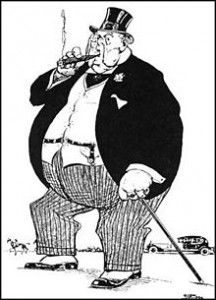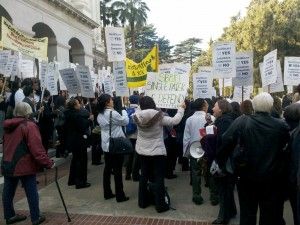California Budget: Austerity or Audacity?
It’s not over.
Even though Gov. Jerry Brown signed the budget on June 30, lawmakers are churning out more legislation. And Capitol legislative committees are currently hearing hundreds of new spending and regulation bills.
Facing a $26 billion budget shortfall, Brown appeared more concerned about signing the budget on time. He vetoed only $23.8 million in the Democrat-approved budget, but approved $15 billion in spending cuts, most of which were not where cuts needed to be made.
Instead, the governor and Democratic Party decided to squeeze the last drop of dignity and civility out of the people, and cut medical services, public safety, more than $1 billion from the state’s higher education university system, tens of millions from public safety and social service and health programs for California’s elderly and disabled people.
The trickle-down effect is inevitable. While local governments have already been cutting police officers and fire fighters, city pools are closing, park maintenance has been shelved, garbage is not getting picked up and local health programs are shuttering. Yet the plan is to cut even more services.
Where cuts should have been made, jobs were spared. Instead of cutting the very visible services and libraries, police officers and fire fighting equipment and tools, the governor should have cut superfluous state union jobs, buried deep within superfluous state programs and agencies. Cities and counties should be doing the same.

Slashing Services
In Sacramento, labor now costs the city more than 80 percent of the total budget. The Sacramento City Council has failed in every way to rein in labor costs, leaving the city’s residents vulnerable, and instead attempted to shore up the deficit by cutting city-provided services.
And while the city council has continued to approve multi-year labor contracts, it has truly kicked the can down the road. Not one labor contract is up for renegotiation this year, but cuts keep coming.
This is exactly what the state has done. It has continued to approve big labor union contracts, saved union jobs and cut core services, hoping to force the people into agreeing to raise taxes.
I attempted to research state spending on labor through the Legislative Analyst’s Office, but found nothing breaking down labor within the budget.
Fortunately, Union Watch did the same and analyzed Brown’s January budget.
The LAO told Union Watch that the cost of labor came in at 12 percent. However, Union Watch wasn’t buying that number, did more digging and found that the state’s numbers are more in line with how cities are spending. “[S]tate employee compensation consumes 84 percent of the state revenues that are retained by the state and not passed through to local governments,” reported Union Watch.
“State Finance Department: Personnel Years and Salary Cost Estimates, 2009-2010, which shows 345,777 full-time state employees in that year, collectively paid $23,104,763,000 in that year, which averages $66,820 each. This does not include benefits.”
But the U.S. Census shows different numbers, with an average salary of more than $70,000 for each of the 338,725 full-time state employees, and does not include benefits.
9/80 Program
Additionally Union Watch found that “if the state did away with the “9/80″ program, a benefit that is, after all, unheard of by the ordinary private sector worker, how many fewer bureaucrats (40 percent of the state workforce) could they hire? The 9/80 program essentially provides state bureaucrats with an extra 26 days off per year, which means if all of them got this benefit and it were eliminated, the state could eliminate 10 percent of their bureaucrats, or 4 percent of the entire state workforce. This is just one example of hidden costs of staggering magnitude.”
The bottom line is that Brown’s first budget plan in January did nothing to cut labor spending, benefits, perks, time-off or pensions. The budget he just signed was no better. In fact, it appears that nowhere in the state is labor spending being addressed or even reined in. Cutting state and local services, but keeping the state and local city employees, only makes the budget more unbalanced.
California is on the verge of insolvency. Ironically, legislators are currently shepherding a bill through the committee process to make it impossible for cities and counties to file for Chapter 9 Bankruptcy — even as the state itself is headed straight for insolvency. Yet the governor just signing a budget gifting public labor unions another year of big salaries, benefits and pensions.
Union Watch addressed how local spending on public employee union labor is a massive problem, with cities spending between 54 percent and 90 percent or their total budgets on labor.
Taxpayers Slapped
Gov. Jerry Brown’s “honest but painful budget” is a farce. The only pain being dished out is the slap in the face to the taxpayers and responsible private sector citizens in the state whose lives are being crushed by local and state governments.
While labor unions continue to garner unheard of benefits for members, legislators continue to push bills to pump up benefits to local government union employees, continuing the expansion of government.
Where or when will the budget farce be exposed?
Maybe when public schools finally collapse under the weight of the teachers who have made their unions the priority over teaching children….
Or when California’s prison system implodes under the burden of the CCPOA contracts….
Or when California’s highways and roads are finally no longer usable because Caltrans workers have more time off than actual work days….
Or when the High Speed Rail scheme is in place, but can’t operate because the union labor contracts are so high, only subsidized state employees can ride it….
Or when the solar, wind and renewable energy regulations in the state have forced all home and commercial property owners into foreclosure for non-compliance….
The list is long and varied, but it is real and it is already happening.
While California’s governor talks of the pain the state’s residents must share, he is really only talking about pain for private sector taxpayers who are losing businesses, homes, and jobs at the hands of the government.
Because Brown just gave another gift of jobs, benefits and pension security to public sector labor unions, the budget isn’t worth the volumes of paper it is printed on. Real cuts and real pain would have elicited outcry from public employee labor leaders. But have you noticed? They are strangely silent.
— Katy Grimes
Related Articles
Brown Targets Corporate Welfare
JAN. 17, 2011 This really could be the beginning of the end for the state’s redevelopment agencies, those noxious, corporate-welfare-enabling
Big Milk and Big Cheese start food fight
March 1, 2013 By Joseph Perkins Dr. Richard Pan, a pediatrician, knows a thing of two about health care. That’s
Video: Interview with Steve Forbes on America’s fiscal cliff
Aug. 13, 2012 By Brian Calle This is the second part of my interview with Steve Forbes, the owner of




